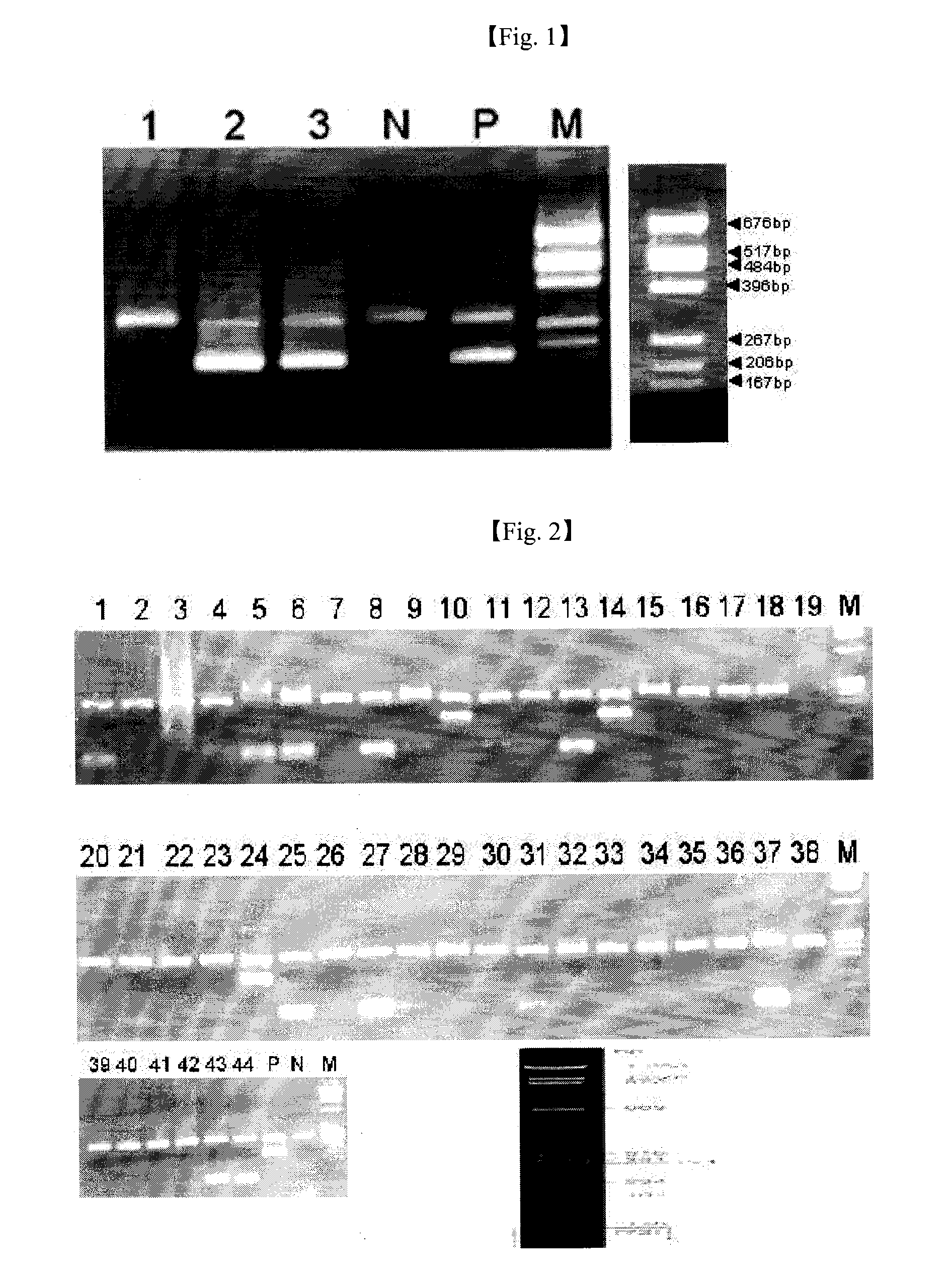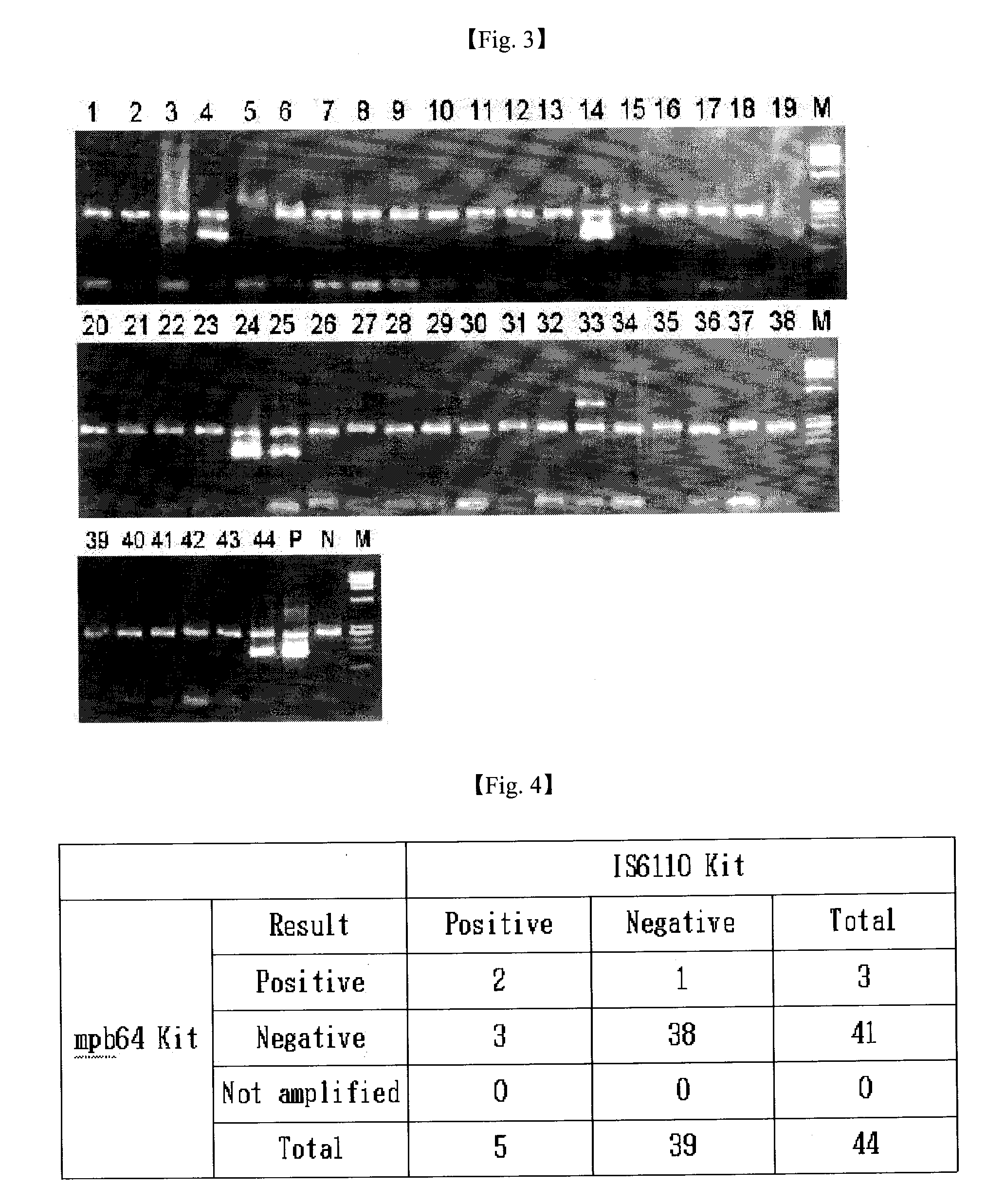Primer composition for detecting mycobacterium sp. and the detection method
- Summary
- Abstract
- Description
- Claims
- Application Information
AI Technical Summary
Benefits of technology
Problems solved by technology
Method used
Image
Examples
example
Example 1
Construction of Primers for Multiplex PCR
[0031]It was confirmed that mpb64-specific primers used herein were primer sequences that can amplify only the M. tuberculosis group (M. tuberculosis and M. bovis) by analyzing the DNA sequence, deposited with accession No. AE000516 in GenBank (www.ncbi.nlm.nih.gov) managed by National Center for Biotechnology Information (NCBI) of U.S. National Institutes of Health (NIH), using a DNAsis program from the company Hitachi Software, sequencing the DNA sequence, and then analyzing the DNA sequence again with BLAST (www.ncbi.nlm.nih.gov / BLAST / ).
[0032]Also, it was confirmed that HLA-DR-specific primers used herein were primer sequences that canamplify only the HLA-DR gene by analyzing the DNA sequence, with accession No. AY305859 deposited in GenBank, using the DNAsis program, sequencing the DNA sequence, and then analyzing the DNA sequence again with BLAST.
[0033]DNA sequences of the constructed primers, and sizes of genes amplified by th...
example 2
Synthesis of the Primers
[0034]The primers analyzed in Example 1 were synthesized by the method such as “Synthesis of Oligonucleotide” described in a paragraph 10.42 of Molecular cloning 3rd ed (Sambrook and Rusell, Cold Spring Harbor Laboratory Press, New York, USA, 2001) using a DNA Synthesizer Model 392 from the company Applied biosystems. The synthesized primers were also purified with an OPC (Oligonucleotide Purification Cartridge) column, quantitified using a UV spectrophotometer, dried using a Speed Vac system, and then dissolved in distilled water to a suitable concentration to obtain a primer composition, which was used as the PCR primers.
example 3
Extraction of Mycobacterial DNA from Clinical Specimen
[0035]2 to 4 of sputum from a suspected tuberculosis patient and an equivalent amount of 4N NaOH were put into a 15 tube, sufficiently stirred, and then centrifuged at 4,000 rpm for 20 minutes. Supernatant was removed and 10 of a PBS buffer (137 mM NaCl, 2.7 mM KCl, 10 mM Na2HPO4, 2 mM KH2PO4) was added into the resultant precipitate, and the resultant mixture was sufficiently stirred, and then centrifuged at 4,000 rpm for 20 minutes. Then, supernatant was removed and the resultant precipitate was transferred to a 1.5 tube, and 1 of PBS buffer was added thereto, stirred, and then centrifuged at 13,000 rpm for 5 minutes. Then, supernatant was removed and 50 to 100 of 5% Chelex 100 resin (Bio-Rad) was added to the resultant precipitate, and the resultant mixture was heated at 100° C. for 20 minutes, and then centrifuged at 13,000 rpm for 3 minuted to obtain DNA supernatant, which was used as a template DNA in a PCR reaction.
PUM
 Login to View More
Login to View More Abstract
Description
Claims
Application Information
 Login to View More
Login to View More - R&D
- Intellectual Property
- Life Sciences
- Materials
- Tech Scout
- Unparalleled Data Quality
- Higher Quality Content
- 60% Fewer Hallucinations
Browse by: Latest US Patents, China's latest patents, Technical Efficacy Thesaurus, Application Domain, Technology Topic, Popular Technical Reports.
© 2025 PatSnap. All rights reserved.Legal|Privacy policy|Modern Slavery Act Transparency Statement|Sitemap|About US| Contact US: help@patsnap.com



